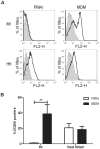The identification of markers of macrophage differentiation in PMA-stimulated THP-1 cells and monocyte-derived macrophages
- PMID: 20084270
- PMCID: PMC2800192
- DOI: 10.1371/journal.pone.0008668
The identification of markers of macrophage differentiation in PMA-stimulated THP-1 cells and monocyte-derived macrophages
Abstract
Differentiated macrophages are the resident tissue phagocytes and sentinel cells of the innate immune response. The phenotype of mature tissue macrophages represents the composite of environmental and differentiation-dependent imprinting. Phorbol-12-myristate-13-acetate (PMA) and 1,25-dihydroxyvitamin D3 (VD(3)) are stimuli commonly used to induce macrophage differentiation in monocytic cell lines but the extent of differentiation in comparison to primary tissue macrophages is unclear. We have compared the phenotype of the promonocytic THP-1 cell line after various protocols of differentiation utilising VD(3) and PMA in comparison to primary human monocytes or monocyte-derived macrophages (MDM). Both stimuli induced changes in cell morphology indicative of differentiation but neither showed differentiation comparable to MDM. In contrast, PMA treatment followed by 5 days resting in culture without PMA (PMAr) increased cytoplasmic to nuclear ratio, increased mitochondrial and lysosomal numbers and altered differentiation-dependent cell surface markers in a pattern similar to MDM. Moreover, PMAr cells showed relative resistance to apoptotic stimuli and maintained levels of the differentiation-dependent anti-apoptotic protein Mcl-1 similar to MDM. PMAr cells retained a high phagocytic capacity for latex beads, and expressed a cytokine profile that resembled MDM in response to TLR ligands, in particular with marked TLR2 responses. Moreover, both MDM and PMAr retained marked plasticity to stimulus-directed polarization. These findings suggest a modified PMA differentiation protocol can enhance macrophage differentiation of THP-1 cells and identify increased numbers of mitochondria and lysosomes, resistance to apoptosis and the potency of TLR2 responses as important discriminators of the level of macrophage differentiation for transformed cells.
Conflict of interest statement
Figures









References
Publication types
MeSH terms
Substances
Grants and funding
LinkOut - more resources
Full Text Sources
Other Literature Sources

